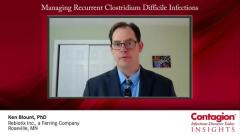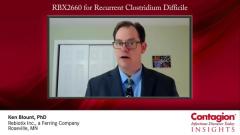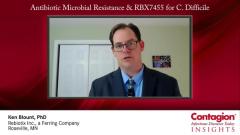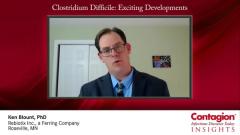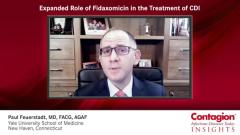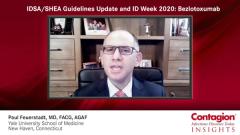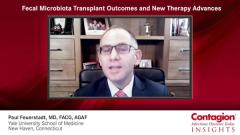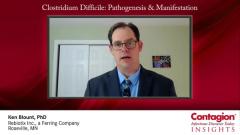
RBX2660 for Recurrent Clostridioides Difficile
Episodes in this series

Transcript:
Ken Blount, PhD: I mentioned the concept of fecal transplant. That’s a procedure that’s conducted in the hospital. RBX2660 is an investigational live biotherapeutic. What that means is it’s developed under the guidelines for the FDA, called Investigational New Drug guidelines, which is aiming toward a potentially approvable product that could be marketed as a typical drug. It is a broad consortium investigational live biotherapeutic. That means that in making RBX2660, we try to capture as much of the healthy microbiome, put that in the investigational product, and administer it to patients.
It’s also what we call standardized and stabilized. Those are very important concepts. Standardized means there are good manufacturing practices that allow us to ensure consistency, dose to dose consistency. When a patient gets a treatment with RBX2660, it would be the same no matter when or where they’re getting it. It’s also stabilized, which means that it has a shelf life, the same as any investigational drug would have. You can store it, you can trace it, you can track where it’s shipped, and you can expect that it should meet quality control guidelines to deliver to the patient a consistent dose. That was the investigational product in the trials that we presented about.
The specific trial is called PUNCHCD2. This was a trial conducted a few years ago. It was the first randomized, double-blind, placebo-controlled trial of this type of investigational live biotherapeutic. It was a really exciting trial at the time. We still find it quite exciting and groundbreaking. The question that trial asked was, what is the efficacy of RBX2660 to prevent or reduce recurrence of C diff [Clostridioides difficile] at 8 weeks after treatment compared to a placebo? That was the concept of the trial and the question we aimed to ask.
We had 3 arms in that trial. We published an interim analysis of that a couple of years ago in which we demonstrated that RBX2660 reduced the recurrence of C diff more than the placebo arm, and that’s highly consistent with the other trials that we’ve run in this space. We’ve run a total now of 5 trials—2 of which are awaiting readout very soon—5 trials in the recurrent CDI [Clostridioides difficile infection] space with this investigational product, RBX2660. This trial, PUNCHCD2, showed very consistent response with the other trials.
In addition to that clinical benefit, we also observed a microbiome change from before to after treatment. I’ve introduced the idea that when patients get C diff, they have a disrupted microbiome, and what we sought to answer was, have we changed that? Have we provided any restoration toward something more resembling a healthy microbiome? What we saw and published was just that. Among participants who responded to RBX2660, there was a very clear and statistically significant restoration of the microbiome from before to after treatment toward something more resembling a healthy population. We published that last year.
In this study that was presented at ID [Infectious Diseases] Week 2020, we really wanted to take a next step in our translational study and say what effect we have on the metabolome.
We talked a lot about microbiome. The metabolome is all the different functions and metabolites that are being affected by the microbiome. Specifically, in this case we looked at bile acids and the composition of bile acids in the participants’ gut from before to after treatment. Bile acids are interesting to this disease. Typically, our body produces primary bile acids in the liver. Those are converted to secondary bile acids by a healthy microbiome. That’s very important to C diff because the primary acids that the liver produces would normally, if you take those and put them in a test tube, stimulate growth of C diff.
Going back to our garden, they give a growth spurt to C diff. But if you have a healthy microbiome, those primary bile acids are quickly converted to secondary bile acids. Again, if we take that and put it in a test tube with C diff, we know that those secondary bile acids actually decrease C diff growth. They inhibit C diff. The model that we set out to test is if we have primary bile acids, we would consider that healthier. If we have secondary bile acids, we would consider that less healthy. When we looked at participants from this PUNCHCD2 trial, we found that prior to treatment with RBX2660, they had a preponderance of primary bile acids. That’s not what we consider a healthy balance, but after treatment they rapidly and progressively shifted to predominance of secondary bile acids.
Again, those are the kind of bile acids that are generally associated with repression of C diff growth and proliferation. That was very consistent with the microbiome results we have seen. It was also very consistent with the clinical outcomes that we had seen, meaning we see a restoration of microbiome and bile acid, and concurrent with that, we see a real benefit to the patients in this trial, in terms of the primary end point being met.
This is a very exciting trial. This was the third trial in which we saw this positive benefit for patients. We’ve since run an additional 3 trials, 2 of which are pending readout. We’ve shared with the public the preliminary positive readout from our large phase 3 pivotal trial. This was the first of its type in the area, a large phase 3 randomized, placebo-controlled trial that was aimed at enabling an approvals process with the FDA. The significance of this trial within our developed program was that it’s building more and more evidence that we would eventually take to the FDA and argue for an approval of this investigational product.
For the industry and for the field at large, particularly for the patient population, it’s another demonstration that this type of standardized process and product has the potential to be a game-changer instead of just treating over and over with antibiotics. We’re aiming to have an approvable product that can restore the microbiome and get patients out of that vicious cycle of recurrence.
From a clinical perspective, we also saw that not only in the first 8 weeks did we see a benefit for reducing recurrence in this trial, but if you carried that out to 24 months—it wasn’t a primary end point of our trial, but it was something that we monitored prospectively—24 months after receiving treatment, the primary responders generally remained recurrence free. What we’re seeing is a durable long-term reduction of C diff recurrence. That’s very exciting, and the clinical significance for the field is tremendous if we can get approvable products like this in their hands.
As for how we would anticipate this being administered in the clinic, I think that’s relatively straightforward. We anticipate it being administered per whatever label we would be granted. We won’t discuss the labeling today, but that’s what we would aim for, and that would be highly consistent with what we’ve tested in the trials, which is about reducing the recurrence at 8 weeks after treatment among patients who have already received standard-of-care antibiotic therapy.
Transcript Edited for Clarity
Newsletter
Stay ahead of emerging infectious disease threats with expert insights and breaking research. Subscribe now to get updates delivered straight to your inbox.

